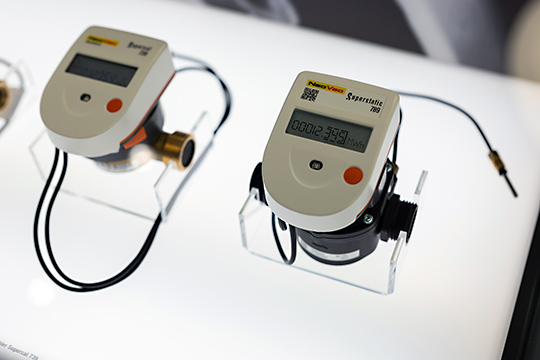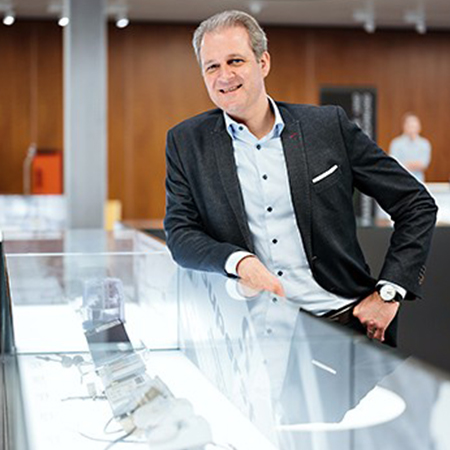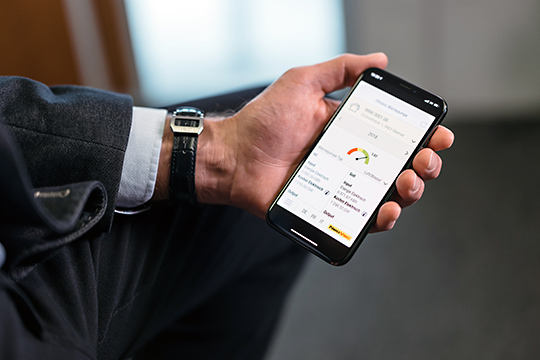IoT ecosystem pays off for buildings
NeoVac is using IoT heat meters to replace annual utility cost settlement with continuous energy monitoring. Meanwhile, it is paving the way for other IoT applications in the smart building market.
15. April 2019, Text: Christoph Widmer, Images: Daniel Brühlmann, © Neovac, Video: TinCan Motion 6 min
Building specialist NeoVac moves with the times.
For many tenants, settling utility costs is still a necessary evil. Reading heat meters requires access to the residence, requiring the tenant either to be at home or to leave a key with a neighbour. The task is equally tedious for the technicians responsible for reading the meters: with clipboard and pen in hand, they usually have no other option than to go from one flat to the next and write down the readings from each meter – at countless properties. An uphill battle of sorts.
Meter reading in the past: up until the mid-1990s, meter readings had to be recorded directly on site from each individual meter. Planning and carrying out the task took months.
When it comes to the efficient monitoring of heating and water consumption in flats and homes, building specialist NeoVac has always moved with the times. The manual reading of water and heat meters was first replaced with closed-circuit radio systems, which allowed meter readings to finally be recorded from a central location inside the building. Now, even that is a thing of the past. For the annual billing of utility costs – one of the main responsibilities of the NeoVac Group, located in the St. Gallen municipality of Oberriet – the company is now using a much more innovative tool: an IoT-based solution.
The future for the building specialists at NeoVac won’t stop at networked energy monitoring. CEO Patrick Lanter reveals his vision for the IoT ecosystem in the video.
Modern energy monitoring
The requirements for modern, energy-efficient buildings have increased over the years, requiring today’s sustainable buildings to be equipped with energy monitoring systems that help to further reduce water and power consumption. ‘We saw a big opportunity here’, explains Patrik Lanter, CEO of the NeoVac Group. ‘Our meters are already used in many buildings, so we knew that if we recorded and analysed the data more often, instead of just once a year for annual billing, we would be able to offer this kind of energy monitoring.’
Patrik Lanter, CEO of the NeoVac Group, is a pioneer of new IoT ecosystems that are helping smart buildings to continue evolving.
But transmitting the data regularly with a dedicated, closed radio system would consume too much energy – which is why NeoVac relies on Swisscom’s Internet of Things solutions and low-power network (LPN). The LoRaWAN-based network allows meters to transmit small bits of data at frequent intervals while consuming very little battery power. NeoVac not only develops IoT-ready heat meters for this purpose, it is also in charge of installing Swisscom LPN gateways in buildings. In this way, it is helping to improve networks inside buildings. The technology is already being used in three buildings, with the plan being to gradually upgrade all devices. In future, this should make it possible to constantly collect data from 400,000 properties (mainly homes) via the Internet of Things.
The expansion of the Swisscom LPN network into buildings, which NeoVac is doing by installing the gateways, is an incredibly worthwhile investment: the LoRaWAN used in buildings will also offer a foundation for integrating IoT services from other providers into the network. In this way, NeoVac is laying the groundwork for IoT ecosystems that make smart building management possible in the first place. Patrik Lanter is certainly convinced: ‘People in the IoT world quickly forget that every newly installed device requires maintenance and support – whether it’s a coffee maker, a stereo system or a heat meter’, he explains. ‘That’s why the requirements of a smart building can never be met by a single company.’
Modern meter reading: the IoT-based compact heat meter sends current meter readings to the data centre via the Swisscom LPN network at 15-minute intervals.
Part of the IoT ecosystem
Solutions like the new myNeoVac app, which offers end users an overview of their energy consumption, should therefore not only work as proprietary applications; they are also integrated into platforms in the form of a micro app. One of these is Allthings: through various partnerships, the modular software consolidates services, such as a parking space search, access control or room bookings. Allthings provides the basis for developing applications for real estate projects that offer tenants, owners and managers a wide spectrum of facility management services. A very promising business model: ‘Many smart building projects have, in theory, already been possible for a long time – but were usually too complicated to execute’, explains Lanter. ‘Solutions only achieve a breakthrough if they are easy to use. This is exactly what these kinds of higher-level platforms do – which is why we also want a seat at the table.’
The new myNeoVAc app can be used to view energy consumption. The Allthings micro app offers additional services, such as a parking space search, access control and room bookings.
The Internet of Things is also allowing NeoVac to expand its core competencies. For example, possible uses could include an air quality monitoring system or a water temperature monitoring system to prevent the growth of Legionella. Partnerships with weather services could help reduce energy consumption even further, for example by detecting when a room is still being heated despite warm temperatures outside or sun exposure.
Managing the data and developing the app is placing new demands on IT – the division of the NeoVac Group that has grown most rapidly in recent years. However, CEO Patrik Lanter believes that the company’s future lies in these new services: ‘In 10 years, we will not just be a service provider for annual utility cost settlement, but also an established partner for energy monitoring and a developer of applications that raise users’ awareness of their energy consumption.’





